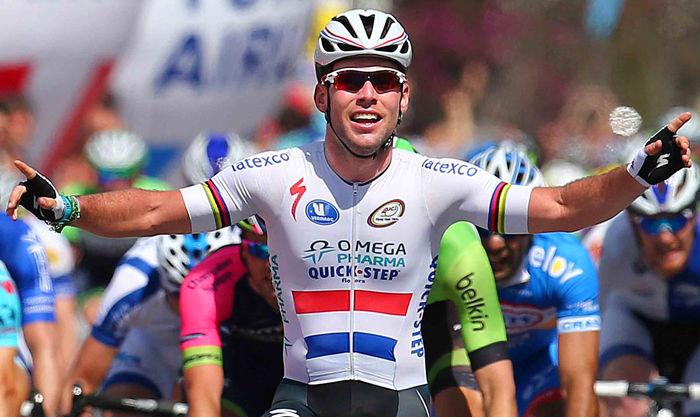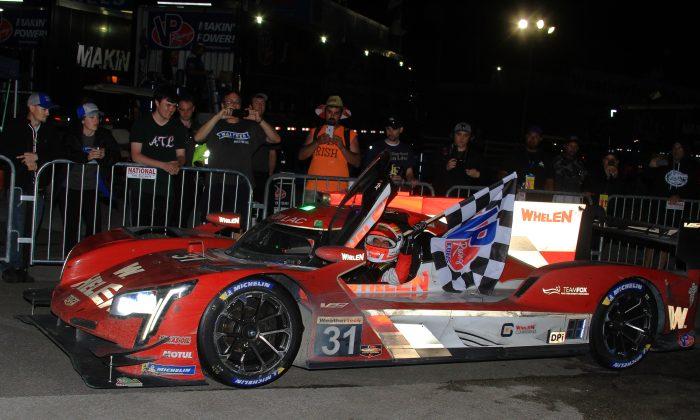Mark Cavendish showed why he can be called “The Fastest Man in the World” without irony with his performance in Stage One of the ninth Amgen Tour of California
After pulling hard for 30 kilometers in a crosswind-induced breakaway in the final 60 km of the 193-km stage, the Omega Pharma-Quickstep sprinter set himself up for the last 300 meters without a leadout, started his sprint late, and still managed to catch Giant-Shimano’s John Degenkolb at the line, winning the race by about two inches.
Omega had spent itself in the breakaway—its normally dominant leadout train was down on power and missing pieces. Mark Resnhaw, the final and most important car in the train, punctured a rear tire in the final ten K and had to push himself hard to get back to the front.
Only Tom Boonen was left to shepherd Cav to the line in the final kilometer, and that was too far for a single rider to pull at leadout speed.
Cavendish was forced to freelance; instead of being pulled at sprint speed to the final 200 meters, he had to jump from wheel to wheel, looking for any edge.
Cavendish was about fifth wheel when Degenkolb started sprinting. Cavendish passed Peter Sagan on the left, cut over to the right, nearly bumping the Cannondale rider, but kept accelerating, cathcing Degenkolb so close to the line both sprinters had to wait for the replay to know which had won.
“I’ve won raced by a few centimeters before, but this is the first time I didn’t know who had won,” Cavendish told NBCSN.
The 193.1 km (120 miles) course for the opening stage of the ninth Amgen Tour of California contained a single Cat Three climb between two other uphills almost as difficult halfway through, but the first 70 of the final 80 km were downhill, and the final ten km flat—a day for the quick men, in other words.
The race ended with three 3.2-km laps around downtown Sacramento, giving Californians an up--close look at some of the best cyclists in the world riding as fast as they could.
Wind played a big role in Stage One—the wind changed directions frequently but stayed strong all day.
A group of six—Tom Leezer (Belkin,) Isaac Bolivar (UnitedHealthcare,) Charles Planet (Team Novo Nordisk,) Eric Young (Optum,) Matt Cooke (Jamis-Hagens Berman,) and Tao Geoghegan Hart (Bissell)—attacked early, assisted by tailwinds, but couldn’t get a gap much over three minutes.
The wind shifted to crosswinds after the climb, threatening to split the peloton, then shifted again to a tailwind, helping the chase, then back to a crosswind. All the big General Classification teams moved to the front in the crosswind to make sure that if the wind split the peloton, the real contenders would not get caught behind. Giant-Shimano also rode up front to keep sprinter John Degenkolb in position to contest the sprint should the field split, but they still got caught.
Sky split the field about 60 km from the finish, pulling away with a group of a 18 riders, with a lot of Omega Pharma-Quickstep and BMC, and riders from NetApp, Belkin, and Trek, Cannondale, and Bissell. Omega’s Mark Cavendish made the split, almost guaranteeing him the stage win. Sky was riding for Sir Bradley Wiggins, their GC contender.
Omega, a Belgian team, had plenty of experience riding in echelon; the weather in that part of the world offers plenty of opportunities to practice. Sky had the experience and foresight, as did BMC—for the rest, this would be a stern education.
Within five kilometers the Sky group opened a minute gap, cutting the gap to the breakaway group to 35 seconds. Back in the peloton, not many riders had the experience to line up in angled echelons to coordinate for the chase; only a couple of teams understood that they needed to organize immediately and cooperate closely or get lost. Some riders panicked and tried to make up ground by individual effort and burned themselves out.
One rider who didn’t make the split was Cannondale’s peter Sagan, who had won ten Tour of California stages in the past two years. He wouldn’t be challenging Cavendish for the sprint in Stage One this year. The front group was flying at 72 kph (45 mph) while the chase was still disorganized.
Trek sprinter Danny van Poppel made the split, but had the terrible luck to puncture a tire, ending his chances for a win. This cut the lead group to 15 riders; a couple others couldn’t support the pace. Orica-GreenEdge sprinter Matthew Goss and BMC’s Greg van Averamaet were the only riders in the lead group who could seriously challenge Mark Cavendish, and Goss had no teammates.
The lead group was Mark Renshaw, Matteo Trentin, Tom Boonen, and Mark Cavendish (Omega); Sir Bradley Wiggins and Luke Rowe (Sky); Greg van Avermaet and Taylor Phinney (BMC); Matthew Busche,Markel Irrizar, and Jasper Stuyven, (Trek); Andreas Schillinger and Zakkari Dempster (NetApp); Laurens Ten Dam and Moreno Hofland (Belkin); Matt Goss (Orica GreenEdge,) and Koen de Kort (Giant Shimano.)
As can happen, the winds shifted again, the lead group tired, and the huge power of the peloton slowly started eating into the lead. Now the question was, had those leaders pushed too hard for too little?
The peloton caught the attackers 22 km from the finish. Two powerful riders, Tom Boonen and Taylor Phinney, immediately attacked. After a few kilometers, this pair realized they didn’t have a chance and sat up. Phinney in particular, needed to save energy for the Stage Two time trial.
Several riders launched little attacks after that, the only one which lasted was a group of three riders, Jacob Rathe (Jelly Belly,) Kiel Reijnen (UHC,) and Gregory Daniel (Bissell.) This trio lasted halfway through the first of three laps, when Rathe and Daniel dropped back, leaving Reijnen on his own. The United Healthcare rider lasted until the start of the final lap, and then it was all about the sprinters’ teams.





